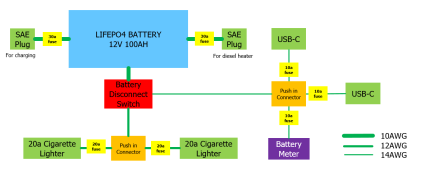reverse01134
New Member
Hello I am building 100ah power bank for camping uses. (diesel heater, phone charging, etc)
No need for inverter so it will be just the battery and 2 usb ports and 2 cigarette lighter sockets. For use of higher amp devices, I found heavy duty cigarette lighter sockets that support 12v 20a. I will add a switch to usb and cigarette lighter sockets to cut any idle wattage.
I have a few dumb questions…
1) Is 20a switch enough to handle 2 usb ports (12v 3a) and 2 cigarette lighter sockets (12v 20a)?
2) 20a cigarette lighter socket uses 14awg. Should I use 14awg for all connections? (Battery - switch - usb/cigarette lighter socket)
3) If I need to add fuses, where should it be located and what size fuse?
Thanks in advance for your help!
No need for inverter so it will be just the battery and 2 usb ports and 2 cigarette lighter sockets. For use of higher amp devices, I found heavy duty cigarette lighter sockets that support 12v 20a. I will add a switch to usb and cigarette lighter sockets to cut any idle wattage.
I have a few dumb questions…
1) Is 20a switch enough to handle 2 usb ports (12v 3a) and 2 cigarette lighter sockets (12v 20a)?
2) 20a cigarette lighter socket uses 14awg. Should I use 14awg for all connections? (Battery - switch - usb/cigarette lighter socket)
3) If I need to add fuses, where should it be located and what size fuse?
Thanks in advance for your help!



